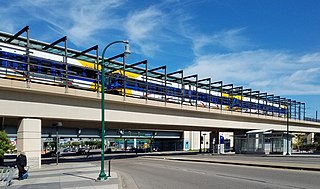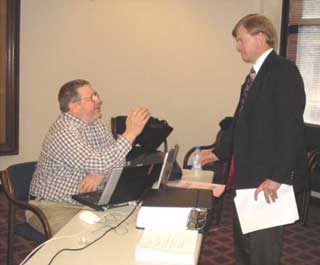Related Research Articles

Personal rapid transit (PRT), also referred to as podcars or guided/railed taxis, is a public transport mode featuring a network of specially built guideways on which ride small automated vehicles that carry few passengers per vehicle. PRT is a type of automated guideway transit (AGT), a class of system which also includes larger vehicles all the way to small subway systems. In terms of routing, it tends towards personal public transport systems.

A people mover or automated people mover (APM) is a type of small scale automated guideway transit system. The term is generally used only to describe systems serving relatively small areas such as airports, downtown districts or theme parks.

Whittier is a neighborhood within the Powderhorn community in the U.S. city of Minneapolis, Minnesota, bounded by Franklin Avenue on the north, Interstate 35W on the east, Lake Street on the south, and Lyndale Avenue on the west. It is known for its many diverse restaurants, coffee shops and Asian markets, especially along Nicollet Avenue. The neighborhood is home to the Minneapolis Institute of Art, the Minneapolis College of Art and Design, and the Children's Theatre Company.

Lake Street/Midtown station, also referred locally as either the Lake Street station or Midtown station, is a Blue Line light rail stop in Minneapolis, Minnesota, United States. The station is located on a bridge over East Lake Street adjacent to Highway 55.
Cabinentaxi, sometimes Cabintaxi in English, was a German people mover development project undertaken by Demag and Messerschmitt-Bölkow-Blohm with funding and support from the Bundesministerium für Forschung und Technologie. Cabinentaxi was designed to offer low-cost mass transit services where conventional systems, like a metro, would be too expensive to deploy due to low ridership or high capital costs.

Morgantown Personal Rapid Transit is a personal rapid transit (PRT) system in Morgantown, West Virginia, United States. The system connects the three Morgantown campuses of West Virginia University (WVU) and the city's downtown area.

The Midtown Greenway is a 5.7-mile (9.2 km) rail trail in Minneapolis, Minnesota that follows the path of an abandoned route of the Milwaukee Road railway. It is considered under segregated cycle facilities.

The Midtown Exchange is a historic structure and mixed-use building located in the Midtown neighborhood of Minneapolis, Minnesota, United States. It is the second-largest building in Minnesota in terms of leasable space, after the Mall of America. It was built in 1928 as a retail and mail-order catalog facility for Sears, which occupied it until 1994. It lay vacant until 2005, when it was transformed into multipurpose commercial space. The building is listed on the National Register of Historic Places as the Sears, Roebuck and Company Mail-Order Warehouse and Retail Store.

Ultra is a personal rapid transit podcar system developed by the British engineering company Ultra Global PRT.

Longfellow, also referred to as Greater Longfellow is a defined community in Minneapolis, Minnesota which includes five smaller neighborhoods inside of it: Seward, Cooper, Hiawatha, Howe and Longfellow. The community is a mix of agri-industrial properties along the old Northern Pacific Railway, expansive parkland surrounding the famous Minnehaha Falls, and smaller residential areas.

Gary Dean Zimmermann is an American politician and member of the Green Party of Minnesota in Minneapolis, Minnesota. He was an elected member of the Minneapolis City Council from 2001 to 2005. Before that, Zimmermann initially served on the Minneapolis Park Board as a member of the Minnesota Democratic-Farmer-Labor Party.

Robert Lilligren is an American politician and member of the Minnesota Democratic-Farmer-Labor Party. He was an elected member of the Minneapolis City Council. He was first elected in 2001, to represent the 8th Ward of the Minneapolis City Council. Following the defeat of Green Party member Dean Zimmermann, during the 2005 municipal elections, Lilligren represented the 6th Ward of the City of Minneapolis. When first elected to office, Lilligren was serving as a volunteer on eight different community boards and commissions including: vice-chair of Phillips West Neighborhood organization, the Midtown Greenway Coalition, the Hennepin County-appointed I-35W Project Advisory Committee, and as a board member for several affordable housing groups throughout South Minneapolis. He lost his re-election bid in 2013 to Abdi Warsame. He was appointed to the Metropolitan Council by Governor Tim Walz in March 2019.
The Minneapolis Streetcar System was a proposed streetcar system for the city of Minneapolis, Minnesota. Extensive studies and plans for the new system were completed in 2007 and presented to the Minneapolis City Council in January 2008; on April 2, 2010, the Council voted to approve the plans and seek funding. On December 21, 2010 the Federal Transit Administration granted $900,000 to further study the Nicollet and Central Avenue corridors. In June 2021, after no further development on the system, a bill authorized the Metropolitan Council to use funds collected for the Nicollet-Central line to be spent on bus rapid transit funding.
The Midtown Farmers Market is a seasonal open-air farmers market in the Midtown area of south Minneapolis. Established in 2003, the market is held Saturdays from May through October, and Tuesdays from June through October in a parking lot in the Corcoran neighborhood. The market is a project of the Corcoran Neighborhood Organization, and is known for a selection of locally produced and organic fare. All of the products sold at the market are grown or produced in Minnesota or Wisconsin by the individual vendors. At the peak of the season, the Saturday market hosts over 70 vendors and draws over 60,000 shoppers each season.

Michael Joseph Opat is an American politician from the U.S. state of Minnesota. He serves on the Hennepin County Board of Commissioners, the governing body for the largest county in Minnesota, with more than 1.25 million residents and an annual budget of $2.4 billion. Opat represents District 1, an area that includes more than 170,000 residents and encompasses six suburban cities: Brooklyn Center, Brooklyn Park, Crystal, New Hope, Osseo, and Robbinsdale. In his time on the County Board, Opat has led, among other initiatives, policy and governance changes at Hennepin County Medical Center, numerous advancements in public infrastructure including the revitalization of the Humboldt Greenway, reconstruction of Highway 100 in the northern suburbs, construction of the new Brookdale library, the construction of Target Field and expansion of the Twin Cities area transit network, including the planned Bottineau Light Rail line along County Road 81 through the northern part of the county.

The Kenilworth Trail is a paved bicycle trail in Minneapolis, Minnesota, United States. It runs nearly 1.5 miles (2.4 km) and acts as a connector between the Cedar Lake Trail in the north and the Midtown Greenway in the south. Like the Cedar Lake Trail, most of the route is composed of a triple-divided cycleway/pedway with a pair of one-way paths for bicycles and another path for pedestrians. On some maps, a southern segment of the Kenilworth Trail is called the Burnham Trail. The trail corridor has been considered the most highly trafficked in the Minneapolis park system.

Hiawatha LRT Trail is a 4.7-mile (7.6 km), multi-use path adjacent to a light-rail transit line in Minneapolis, Minnesota, United States, that is popular with bicycle commuters. Users travel along the Metro Blue Line and Hiawatha Avenue transit corridor, reaching downtown Minneapolis near an indoor sports stadium at the trail’s northern end, and reaching a bridge above Minnehaha Creek at the trail’s southern end. Hiawatha LRT Trail provides a vital link between several Minneapolis neighborhoods and the city’s downtown area.

Little Earth Trail is an approximately 1-mile (1.6 km), multi-use bicycle path in Minneapolis, Minnesota, United States, that links several neighborhoods, parks, businesses, and trails in the Phillips community. The trail begins at its northern end near the intersection of East Franklin Avenue and 16th Avenue South and eventually follows the west side of Hiawatha Avenue to the Midtown Greenway and Martin Olav Sabo Bridge. Named after the nearby Little Earth community, the shared-use pathway provides transportation and recreation opportunities, and is a frequent location of activism on social justice issues in Minneapolis.
In the 1990s, the Regional Transportation Authority (RTA) planned to fund the construction of a personal rapid transit (PRT) system in Rosemont, Illinois. Raytheon had been contracted to build the system. The project was cancelled in October 1999. Rosemont had been selected in 1993 by the RTA be home to a demonstration PRT system. Five other municipalities in the suburban Chicago metropolitan area had submitted unsuccessful bids to be host to the PRT project. The system would have been the first-of-its-kind, utilizing smaller vehicles than the existing Morgantown Personal Rapid Transit. The project marked the first serious activity related to PRT construction since Morgantown Personal Rapid Transit.
References
- ↑ Societies, American Association of Engineering (15 March 1991). Who's who in Engineering. Engineers Joint Council. ISBN 9780876150160 – via Google Books.
- ↑ "Advanced Transit Association (ATRA)". Advancedtransit.org. Archived from the original on March 1, 2009. Retrieved 2010-02-07.
- ↑ "Archived copy" (PDF). Archived from the original (PDF) on February 6, 2012. Retrieved June 6, 2012.
{{cite web}}: CS1 maint: archived copy as title (link) - ↑ Anderson, J. Edward, "How Innovation can make Transit Self-Supporting," Archived September 27, 2007, at the Wayback Machine p.19. Prepared for The Conference of Georgist Organizations, July 19–23, 2006
- ↑ "The Rake: The Rakish Angle : The Future >> My Pod". Archived from the original on 2007-09-28. Retrieved 2006-12-10.
- ↑ Boston University, "Will Taxi 2000 be the Rapid Transit of the Future?" Archived 2007-01-08 at the Wayback Machine Bostonia, Jan.-Feb. 1988.
- ↑ "For Immediate Release". Faculty.washington.edu. Archived from the original on 2007-01-17. Retrieved 2010-02-07.
- ↑ "Taxi 2000". Itdean.umn.edu. 2004-10-01. Archived from the original on 2010-06-13. Retrieved 2010-02-07.
- ↑ "Response to "Personal Rapid Transit – Cyberspace Dream Keeps Colliding with Reality," found on www.lightrailnow.org" (PDF). 2004. Archived from the original (PDF) on February 10, 2012. Retrieved December 10, 2006.
- ↑ "Current Efforts". Faculty.washington.edu. 2001-05-11. Archived from the original on 2007-02-08. Retrieved 2010-02-07.
- ↑ Central Area Loop Study Archived May 13, 2012, at the Wayback Machine
- ↑ "Central Area Loop Study (CALS) Ending". www.skyloop.org. Archived from the original on 2008-05-09.
- ↑ Driehaus, Bob (2001-09-26). "OKI rejects 'sky loop' elevated rail system". The Cincinnati Post . E. W. Scripps Company. Archived from the original on 2006-12-05.
- ↑ "Finance and Commerce". Archived from the original on 2003-06-27. Retrieved 2010-02-07.
- ↑ "Midtown Greenway Coalition". midtowngreenway.org. Archived from the original on 25 May 2004. Retrieved 17 January 2022.
- ↑ "Midtown Greenway Coalition". midtowngreenway.org. Archived from the original on 27 September 2007. Retrieved 17 January 2022.
- ↑ Reilly, Mark (2005-06-17). "Funds to help Bioverse clean MN lakes - Minneapolis / St. Paul Business Journal". Twincities.bizjournals.com. Retrieved 2010-02-07.
- ↑ "Get On Board|Taxi2000 News & Intel". Kinetic.seattle.wa.us. Archived from the original on 2009-02-17. Retrieved 2010-02-07.
- ↑ "The MX Basing Debate: The Reagan Plan and Alternatives : UNT Digital Library" (PDF). Digital.library.unt.edu. 2 November 1981. Retrieved 2010-02-07.
- ↑ "First Strike: Myth or Reality," The Bulletin of the Atomic Scientists, 37:9 (1981):6-11
- ↑ "J. Edward Anderson: The Complete Bibliography". Kinetic.seattle.wa.us. Archived from the original on 2009-09-03. Retrieved 2010-02-07.
- ↑ "War, Doctrine, and the Air War College". Airpower.maxwell.af.mil. Archived from the original on 2011-06-08. Retrieved 2010-02-07.
- ↑ "First-strike attack by Soviets destined to bomb." Daily Utah Chronicle, October 29, 1981, p.4
- ↑ MAP Resource People - 2004, Minnesota Alliance of Peacemakers, Retrieved on 10 September 2008.